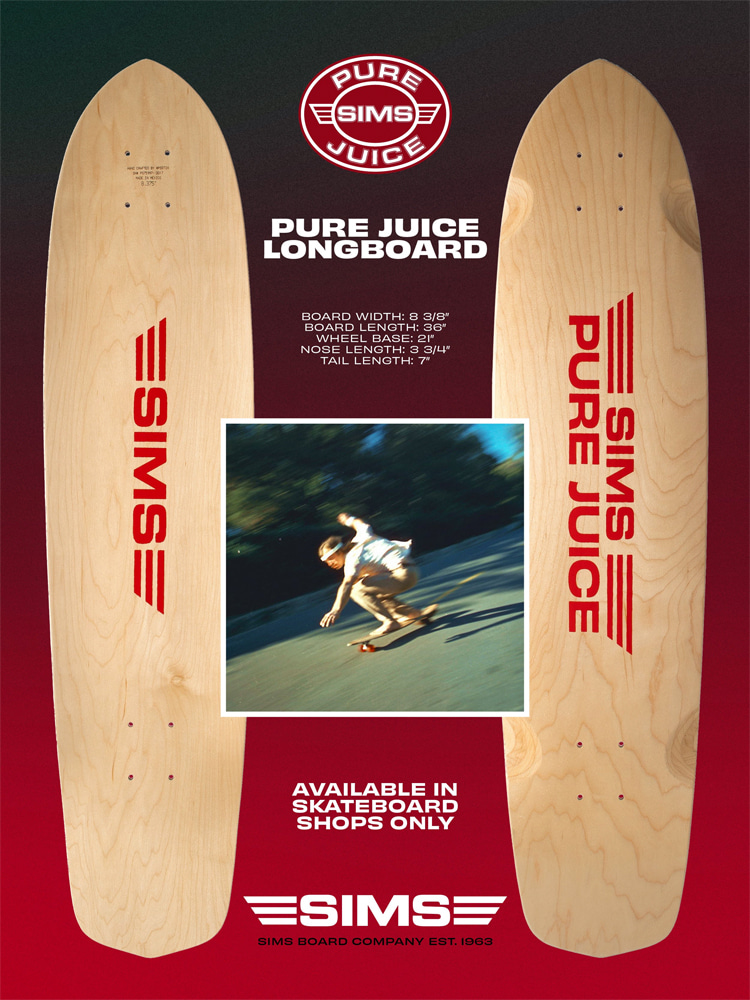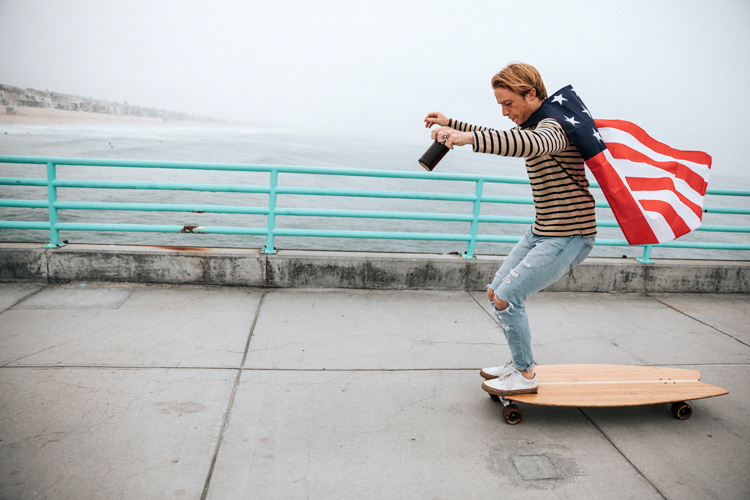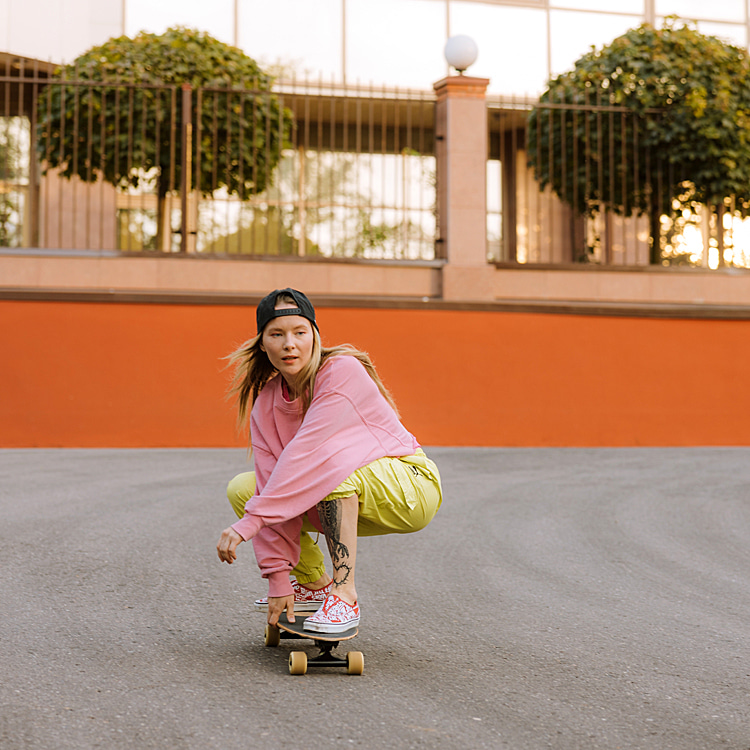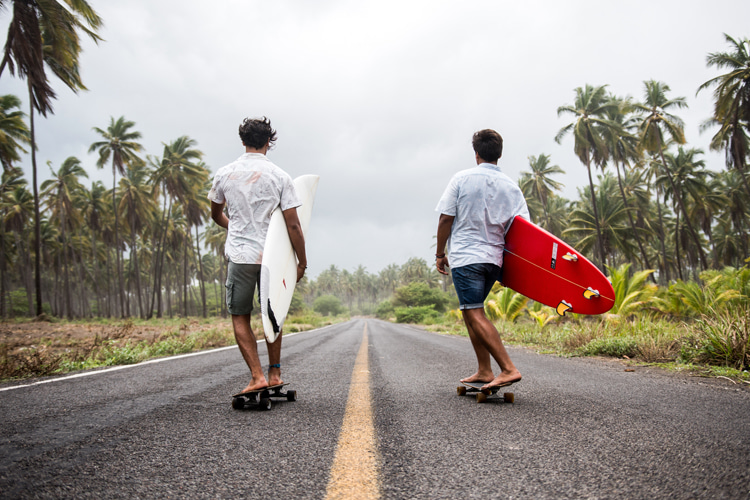The history of longboarding goes back to the roots of skateboarding, particularly in 1950s Southern California surf culture.
Longboards are large skateboards that were originally made for cruising or downhill speed. They range in length from 35 inches to 60 inches.
The name comes from longboard surfboards, which are much larger than traditional surfboards.
Longboarding has always been around in various forms but, until recently, garnered little attention from the skate-and-surf press.
Perhaps this is because its appeal is not so immediately apparent as the stunts performed by street skaters.
But more and more skaters are giving it a try and becoming converts.
As with other types of skateboards, efforts have been made to improve and refine longboard design.

The Legacy of Tom Sims
In the 1970s, a number of people got involved with longboards, but perhaps the greatest proponent of the sport was Tom Sims (1950-2012).
Tom was known for his extremely fluid style with a longboard.
He originally started with water skis and experimented with a variety of wood and wood laminates.
Other longboard pioneers of the 1970s were Ed Economy and Brad Stradlund. Brad recalls the roots of his longboard career.
"The way I looked at it, surfers were my influences on skateboarding. When I started riding skateboards in 1975, there were no real skateboarding heroes," reveals Stradlund.
"I tried to style my skateboarding after surfers like Gerry Lopez, Buttons, and Larry Bertlemann."
"All I wanted to do was skate like them. I wanted to be relaxed and smooth - just like Lopez was when he surfed the Pipeline."
Over time, Brad would adopt a more aggressive style with his longboarding due to the influence of Jay Adams.
However, he kept a smooth style as a result of skating with Tom Inouye. Ed Economy feels that skateboarding is just another form of expression.
"Going fast, carving lines and pretty much like I'm pretending that I'm surfing on the pavement," notes Economy.

The Cult of the Longboard
In 1978, SkateBoarder magazine featured a story entitled "The Cult of the Longboard," which profiled some of the top longboarders.
However, other than this piece, longboards weren't prevalent in the 1970s.
In the punk decade, the discipline was kept under the radar, and only a few dedicated enthusiasts continued building boards in garages.
In the 1980s, Madrid Skateboards manufactured a few models, and Thrasher magazine covered several downhill events.
For the most part, though, longboarding was only practiced by a select few.
Nevertheless, it should be noted that Schmitt Stix did manufacture and sell a fair number of 36-inch Yard Stix.
These boards were fun to ride and nearly perfect for cross-stepping, but they were very stiff.

The 1990s and the Longboarding Revival
In the early 1990s, friends Steve Lake and Dennis Telfer from La Jolla, California, formulated an idea that led to the revival of longboarding.
Their goal was to build a product that rode more like a surfboard or snowboard.
Starting in their backyard and quickly progressing to a full-blown factory, Sector 9 dramatically impacted the skateboarding world.
Along the way, others have joined in on the process, and the newly designed reverse kingpins added extra stability to the longboard.
Gravity Streetboards have added hand-painted graphics to their boards, along with the option of a speedometer.
Envy Skateboards' Mike Shanahan was a one-time champion snowboarder who experienced a painful injury that ended his career.
So, he decided to change direction.
"Everybody's thought about putting skateboard trucks onto a snowboard - but it doesn't work," underlined Shanahan.
"So basically, what I did was design the holes into the board so you wouldn't get any wheel bite."
Compression Technologies created longboards made from hemp, which adds to the boards' durability and strength.

A Unique Riding Proposition
Besides their larger shape, longboards have one other feature that makes them quite different when compared to modern regular-sized skateboards - the wheels are much larger and softer.
While most skateboard wheels are between 50 and 60 mm with a durometer of 98 to 101, longboard wheels are 60 to 80 mm with a hardness scale of 78 to 82.
This ensures a smooth ride and fewer hangups on cracks in the sidewalk.
Even the traditional, regular-sized skateboard manufacturers now include longboards as part of their offering.
With the advent of the internet, Malakai Kingston's Silverfish Longboarding created an online community in which riders had lively talks and discussions on their favorite sidewalk surfing discipline.
The digital forum was a success and helped bring longboarding into the mainstream, either by keeping current riders engaged or capturing new audiences and fans.
Although most longboarders are content to cruise and carve, new school skaters are adding their own signature moves to the sport with insane ollie variations on 48-inch boards.
A Bright Future
While it remains to be seen just how large a movement longboarding will become, there is no question that it is starting to build as a popular cross-training exercise for surfers and snowboarders.
Longboarding is also bringing more women, surfers, and former skateboarders into the sport, which should have a positive effect on the overall sport of skateboarding.
Today, the longboard skateboard has several uses: transportation, traveling, cruising and commuting, free riding, downhill racing, dancing, and slalom course racing.
The long four-wheeled board is even leading the electric skateboarding revolution.
Longboards have become must-have equipment in any skater or surfer's quiver thanks to extended durability, wider turning radius, and improved stability and traction.
Words by Michael Brooke | Skateboarder and Author of "The Concrete Wave: The History of Skateboarding"
